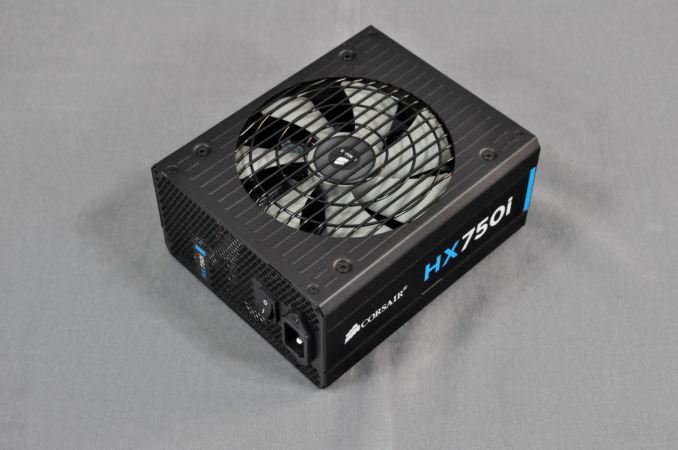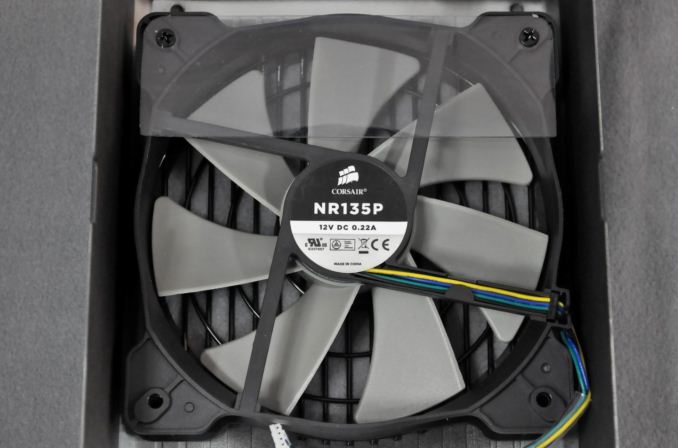Corsair HX750i Power Supply Review
by E. Fylladitakis on January 14, 2015 10:00 AM EST- Posted in
- Cases/Cooling/PSUs
- Corsair
- PSUs
- HXi Series
External Appearance
Visually, the Corsair HX750i stands out from the crowd. It's housed in a 180mm long chassis, which is considerably longer than a standard ATX chassis. Such a long chassis could be a problem in compact cases designs but it is not likely that any modern ATX tower case would not have enough space to accommodate the HX750i. The body has been sprayed with a satin black paint and decorative stickers cover the largest portion of its two sides. Further aesthetic improvements include chamfered edges and embossed parallel ridges aligned with the fan's finger guard design. The sticker with the specifications of the PSU can be found on the top of the chassis (opposite the fan).
The front of the chassis is littered with the connectors for the modular cables. The CPU and PCI Express cables share the same connectors, while the split 10-14 pin connector is for the 24-pin ATX cable and the smaller connectors are for SATA/Molex cables. There are also two connectors for the Corsair Link interface, one Mini-USB for direct connection to an internal USB header or a four-pin PMBus cable for connection to a Commander unit.
Internal Design
A grey blade 135mm fan takes care of the cooling that the HX750i requires at higher loads. At lower loads and depending on the temperature, the fan of the HX750i will not operate at all. It has a rifle bearing and a maximum speed of about 1600 RPM. With the UL number pointing back to Corsair, we cannot identify the OEM of the fan, as Corsair appears to be the manufacturer of these fans.
The interior of the HX750i is where things become truly interesting. The HX750i is based on a Channel Well Technologies (CWT) design, a company that goes way back with Corsair and who built many of their earlier units. It is also nearly identical with the platform used for the RM series. The heatsinks are not much more than simple quadrangular metallic slabs with minimal heat dissipation surface, but they ought to be adequate for the cooling needs of the very efficient HX750i, especially since the same heatsinks were enough for the RM1000.
The 400V / 390μF APFC capacitors are supplied by Nippon Chemi-Con, as is every other electrolytic capacitor inside the HX750i. The polymer capacitors come from Apaq, a Taiwanese manufacturer. The quality of the components appears to be the only major improvement over the RM series, in which we found components mainly from Taiwanese manufacturers instead. The filtering stage begins at the back of the AC receptacle, where we found two of the Y capacitors. There are a total of six Y capacitors, three X capacitors, and two filtering inductors -- a reasonable amount of components for a good filtering stage.
As far as the build quality goes, CWT did a magnificent job with the HX750i. The soldering job is excellent, competing with the best that we have ever seen. If not for a little excessive use of solder at a few points, it would grade as immaculate. The factory used a lot of glue to secure most components, improving the mechanical cohesion of the unit. An extra application of lacquer and glue can be seen on the inductors, as well as heatshrink/tape covering, most likely to minimize the chance of vibration-generated noise (also known as "coil whine").
























32 Comments
View All Comments
Tuvoc - Tuesday, January 20, 2015 - link
I'm still using both an HX520W and an HX620W power supply, they have stood the test of time ! Excellent PSUs giving excellent service several years after purchase..BaRaKuda - Friday, August 14, 2015 - link
Forget the haters! this is a great PSU and a great review. You've gotta love the quality of Corsair's PSUs and the warranties are great. I have the HX750, (not the HX750i), it's Gold Cerified but came withe a 7yr warranty. It has been running great for the past 3 years.